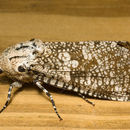Conservation Status
provided by University of Alberta Museums
At the northern edge of the range in Alberta ; uncommon and of no concern.
- license
- cc-by-nc
- copyright
- University of Alberta Museums
Cyclicity
provided by University of Alberta Museums
Adults have been collected in Alberta from late May through July.
- license
- cc-by-nc
- copyright
- University of Alberta Museums
Distribution
provided by University of Alberta Museums
Widespread in eastern North America, west to California and north and west to south central BC. In Alberta, they have been collected along the southern edge of the Boreal forest region (Lac la Biche; Edmonton area) and south to the valleys of the arid grasslands (Writing-on-stone). They are absent or rare in the Foothills and Mountain regions of the province.
- license
- cc-by-nc
- copyright
- University of Alberta Museums
General Description
provided by University of Alberta Museums
"Strongly sexually dimorphic. Males are smaller (wingspan about 5 cm) with narrow, somewhat pointed forewings that are grey with darker grey mottling. The hindwings are thinly scaled, with a black basal area, a thin black terminal line and a large bright yellow-orange splotch at the anal angle. Females are much larger (6-7.5 cm wingspan), dirty white with a mesh-like overlay of fine dark lines and wider dark lines that fill in some of the spaces, especially in the median area, and give it a blotchy appearance. The hindwings are similar, but the overlay is less distinct and lacks the wider lines and blotchy appearance. Both sexes have narrowly bipectinate antennae.
Males may be mistaken for a small sphinx moth, but can be recognized by their bipectinate antennae. Females can be separated from the similar Acossus populi by the blotchy grey on the forewings, and from A. centerensis by the grey hindwings."
- license
- cc-by-nc
- copyright
- University of Alberta Museums
Habitat
provided by University of Alberta Museums
Mature and mixedwood forest; hardwood ornamental and shelterbelt plantations.
- license
- cc-by-nc
- copyright
- University of Alberta Museums
Life Cycle
provided by University of Alberta Museums
The larvae are borers, and live in galleries they create in the trunks and stems of hardwood trees, where they feed on the cambium area. On the prairies, the larvae take up to 3-4 years to complete development. They are 5-7.5 cm long at maturity, greenish white with brown heads and thoracic shields or pinkish with brown spots and reddish brown heads and shields. Pupation occurs in the tunnels during the spring of their final year. Their galleries can weaken trees, making them more vulnerable to wind damage and drought. They can be a pest in shelterbelt and ornamental plantings on the prairies, but they are not abundant enough to be of much concern in Alberta. Adults are usually collected at light.
- license
- cc-by-nc
- copyright
- University of Alberta Museums
Trophic Strategy
provided by University of Alberta Museums
No Alberta data. In the prairies, principle hosts include: shelterbelt and other plantings of poplars (Populus), Green Ash (Fraxinus pennsylvanica). Trembling aspen (P. tremuloides), Black cottonwood (P. trichocarpa), Eastern cottonwood (P. deltoides) and willow (Salix sp.) have been recorded as hosts elsewhere in Canada, and a wide variety of hardwoods, including maple, oaks and elm have been recorded as hosts where they occur.
- license
- cc-by-nc
- copyright
- University of Alberta Museums
Prionoxystus robiniae
provided by wikipedia EN
Prionoxystus robiniae, the carpenterworm moth or locust borer, is a moth of the family Cossidae.[1] It was first described by Peck in 1818 and it is found in southern Canada and most of the United States.

Female (left) and male (right)
The wingspan is 43–85 mm. Adults are on wing from May to July depending on the location.
The larvae feed on locust, oak, chestnut, poplar, willow, maple and ash. The species is considered a pest, because the tunnels the larvae create decrease the value of hardwood lumber.
References

- license
- cc-by-sa-3.0
- copyright
- Wikipedia authors and editors
Prionoxystus robiniae: Brief Summary
provided by wikipedia EN
Prionoxystus robiniae, the carpenterworm moth or locust borer, is a moth of the family Cossidae. It was first described by Peck in 1818 and it is found in southern Canada and most of the United States.

Female (left) and male (right)

Caterpillar
The wingspan is 43–85 mm. Adults are on wing from May to July depending on the location.
The larvae feed on locust, oak, chestnut, poplar, willow, maple and ash. The species is considered a pest, because the tunnels the larvae create decrease the value of hardwood lumber.
- license
- cc-by-sa-3.0
- copyright
- Wikipedia authors and editors


 Female (left) and male (right)
Female (left) and male (right)  Caterpillar
Caterpillar